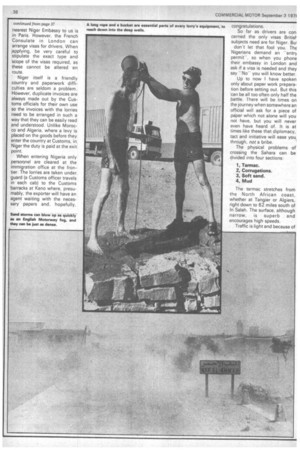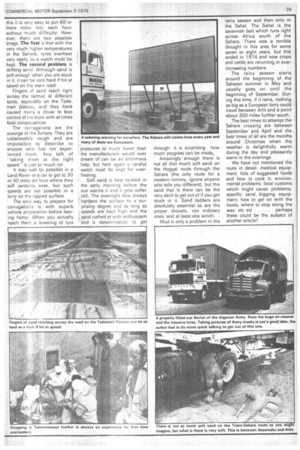First do the . pa
Page 38

Page 39

Page 40

Page 41

If you've noticed an error in this article please click here to report it so we can fix it.
Exporters are looking with increasing interest at the overland route to Nigeria, across the Sahara Desert. The advantages of a door-to-door service are attractive but the route brings hauliers its own unique set of problems. CM has commissioned travel consultant Jim Gavin, who led the first successful crossing of the Sahara by a modern truck convoy, to give us the advantage of his advice.
THE MOST DIFFICULT part of tackling the Sahara by truck is the paperwork which precedes the trip. Not that there aren't dangers today in crossing the desert: but the solutions are clear cut. If a lorry is stuck in the sand, dig it out . . . And the man who doesn't read up a few tips is a fool.
However, let's take things as they come . . .
To those of us used to operating throughout Europe and Scandinavia and to a certain extent to the Middle East, paperwork may at times cause difficulties. But at least these are usually the traveller's own fault and although the delays are frustrating they can normally be overcome within a matter of hours. In Africa the story is very different.
The greatest difficulty in preparing the paperwork for a trans-Sahara journey is in trying to find out just exactly what paperwork you should be preparing. Normally, one begins by approaching the commercial departments of any British Embassies en route, but in Africa the results of such approaches, whether they be personal visits or by letter or telex, invariably leave the would-be exporter more confused than before he started.
In Algiers (Algeria is the biggest and most important country on the whole trip) the Embassy commercial department actively discourages convoys.
To people who come looking for information they issue. a duplicated sheet of paper which contains a certain amount of information but neglects to give the hard facts so necessary to the success of any venture. These include: • Positive lists of entry, transit and exit papers for both trucks and personnel; • Up-dated addresses of Algerian Departments and offices which must be contacted with the names of the best men to get in touch with, and the times of opening; • Do's and dont's for drivers going south so as to stay out of trouble with the police, military and daira; bureaux which must be visited and thase which should be visited (for safety) along the way; • And instructions as to how and from where contact can be made with the UK or the Embassy in an emergency.
If you arrive by ship at Algiers then Algeria is naturally the first country to transit, but there is another way to bring trucks in; by road from Tangier in Morocco.
Starting the overland journey in Tangier has many advantages. The port suffers from little if any congestion, certainly nothing like Algiers, and provided just a little care is taken in preparing the limited documents necessary before arriving. Customs formalities need not take longer than half a day.
Once clear of Tangier a single day's travel will bring the trucks to the Algerian frontier town of Maghnia. After clearing Customs, another day (albeit a long one) will take the lorries, on tarmac the whole way, to Laghout on the Trans-Sahara Highway well south of Algiers.
There is a snag. The constant state of political unrest between Algieria and Morocco makes the Maghnia crossing a little uncertain at times and if your paperwork is not absolutely correct the Algerians will make no move to help, because you have come through Morocco, and it will be necessary for someone to leave the trucks and go to Algiers to sort it out.
One last point to watch when crossing Algeria is that although the exit frontier to Niger, the next country, is at In Guezzam which is south of the area known as the Tassili du Hoggar, the actual frontier formalities are completed at Tamanrasset 247 miles to the north before ever reaching the frontier. So remember this, or you and the whole convoy will be sent back.
Great Britain does not have an Embassy in Niger and the 'nearest Niger Embassy to us is in Paris. However, the French Consulate in London can arrange visas for drivers. When lapplying, be very careful to stipulate the exact type and scope of the visas required, as these cannot be altered en route.
Niger itself is a friendly country and paperwork difficulties are seldom a problem. However, duplicate invoices are always made out by the Customs officials for their own use so the invoices with the lorries need to be arranged in such a way that they can be easily read and understood. Unlike Morocco and Algeria, where a levy is placed on the goods before they enter the country at Customs, in Niger the duty is paid at the exit point.
When entering Nigeria only personnel are cleared at the immigration office at the frontier. The lorries are taken under, guard (a Customs officer travels in each cab) to the Customs barracks at Kano where, presu'mably, the exporter will have an agent waiting with the necessary papers and, hopefully, So far as drivers are con. cerned the only visas British subjects need are for Niger. Bul
don't let that fool you. The Nigerians demand an "entry permit", so when you phone their embassy in London and ask if a visa is needed and they say "Noyou will know better,
Up to now I have spoken only about paper work preparation before setting out. But this 'can be all too often only half the battle. There will be times on the journey when somewhere an official will ask for a piece of paper which not alone will you not have, but you will never even have heard of. It is at times like these that diplomacy, tact and initiative will ease you through, not a bribe.
The physical problems of crossing the Sahara can be divided into four sections: 1, Tarmac.
2, Corrugations.
3, Soft sand.
4, Mud The tarmac stretches from the North African coast, whether at Tangier or Algiers, right down to 62 miles south of In Salah. The surface, although narrow, is superb and encourages high speeds.
Traffic is light and because of this it is very easy to put 60 or more miles into each hour without much difficulty. However, there are two possible snags. The first is that with the very much higher temperatUres, in the Sahara, tyres overheat very easily so a watch must be. kept. The second problem is drifting sand. Although sand is soft enough when you are stuck in it, it can be rock hard if hit at speed on the main road.
Fingers of sand reach right across the tarmac at different spots, .especially on the TadeMalt plateau, and they hay& caused many a driver to lose control of his truck with at times fatal consequences.
The. corrugations are the scourge of the Sahara. They are unbelievably rough and are impossible to describe to anyone who has not experienced them. Any talk of -taking them at the right speedis just so much rot.
It may well be possible in a Land-Rover or a car to get to 30 or 40 miles an hour where they will certainly ease, but such speeds are not possible in a lorry on the rippled surface.
The:only way to_ prepare for corrugations is with superb vehicle preparation before leaving home. VVhen you actually. reach them a lowering of tyre
pressure& to much lower than the manufacturers would ever dream of can be an enormous help, but here again a careful watch must be kept for overheating.
Soft sand is best tackled in the early mornmg before the sun warms it and it gets softer still. The overnight dew always harde.ns the surface to a surprising degree and as long as *speeds are kept high and the sand rushed at with enthusiasm and a determination to get through, it is surprising how much progress can be made, Amazingly enough there is not all that much soft sand on the Hoggar route through the Sahara (the only route for a modern convoy, ignore anyone who tells you different), but the sand that is there can be the very devil to get out of if you get stuck in it. Sand ladders .are absolutely essential as are the proper shovels, not ordinary ones, and at least One winch.
Mud is only a problem in the
rainy season and then only in the Sahel. The Sahel is the savannah belt which runs right across Africa south of the Sahara. There was aterrible drought in this area for some seven or eight years, but this ended in 1974 and now crops. and cattle are returning in everincreasing numbers.
The rainy season starts, around the beginning of. the Saharan summer in May and usually goes on, until the beginning of September. During this time, if it rains, nothing as big.as a European lorry could travel between Arlit.and a point about 300 miles further south.
The best times to attempt the Sahara crossing are between September and April and the best times of all are the months around Christmas when the weather is delightfully warm during the day and pleasantly warm in the evenings.
We have not mentioned the route in detail; medical equipment; lists of suggested foods and how to cook it; environmental problems; local customs which. might cause problems; specific sand, digging equipment; how to get on with the locals; where to stop along the way; etc etc perhaps these could be the subject of another article?.




















































































